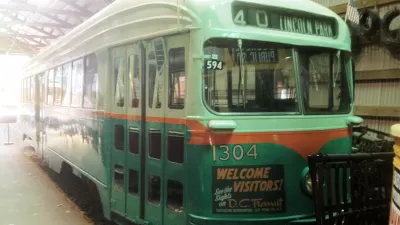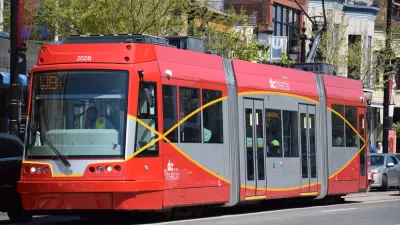In January, Washington D.C. Mayor Vincent C. Gray claimed that the district's new streetcar would open in February. Still not open, the D.C. City Council this week slashed future streetcar spending.

An article by Emily Washington shares news of the vote by the Washington D.C. City Council to cut future streetcar spending as part of a tax reform package, but the majority of the post is dedicated to explaining the limitations of the forthcoming Streetcar, which will run along the district's H Street corridor.
First, Washington paraphrases earlier coverage of streetcars after noticing that many D.C. Streetcar advocates have been touting the project's economic benefits, rather than it's transportation benefits: "the benefits of streetcar over bus depend heavily on streetcars having dedicated lanes, which most of DC’s streetcars wouldn’t have."
Then there is the impact of the streetcar infrastructure on other modes: "In Toronto, streetcar tracks are a factor in nearly one-third of serious bicycle accidents."
Washington also raises the question of where the line's potential ridership: "this streetcar will only provide effective transportation for people visiting H Street retail destinations from the adjacent residential neighborhoods. It does not connect residential neighborhoods to job centers."
And then again, the impacts of the streetcar on other modes: "The H Street corridor has the one of the city’s busiest bus routes with an average of over 15,000 riders each weekday. Unlike the streetcar, the X1, X2, and X9 buses actually connect residential neighborhood’s to job centers and they serve passengers who live farther east in Anacostia. The streetcar will reduce the effectiveness of these valuable routes by adding to delays and reducing frequency as a result."
For more on the tax package approved by the City Council, see an earlier post by David Alpert, which explains the differences between the city council's package and the mayor's: "the change will devote about $400 million for the streetcar over five years. The mayor's proposal dedicates about $800 million over five years, rising to $3 billion over ten years."
FULL STORY: DC streetcar: Worse than nothing

Trump Administration Could Effectively End Housing Voucher Program
Federal officials are eyeing major cuts to the Section 8 program that helps millions of low-income households pay rent.

Planetizen Federal Action Tracker
A weekly monitor of how Trump’s orders and actions are impacting planners and planning in America.

Ken Jennings Launches Transit Web Series
The Jeopardy champ wants you to ride public transit.

California Invests Additional $5M in Electric School Buses
The state wants to electrify all of its school bus fleets by 2035.

Austin Launches $2M Homelessness Prevention Fund
A new grant program from the city’s Homeless Strategy Office will fund rental assistance and supportive services.

Alabama School Forestry Initiative Brings Trees to Schoolyards
Trees can improve physical and mental health for students and commnity members.
Urban Design for Planners 1: Software Tools
This six-course series explores essential urban design concepts using open source software and equips planners with the tools they need to participate fully in the urban design process.
Planning for Universal Design
Learn the tools for implementing Universal Design in planning regulations.
Ada County Highway District
Clanton & Associates, Inc.
Jessamine County Fiscal Court
Institute for Housing and Urban Development Studies (IHS)
City of Grandview
Harvard GSD Executive Education
Toledo-Lucas County Plan Commissions
Salt Lake City
NYU Wagner Graduate School of Public Service




























